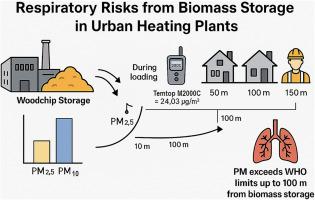Assessment of particulate matter exposure associated with biomass storage in urban heating plant
IF 2.7
引用次数: 0
Abstract
This study assessed the airborne particulate matter (PM) in urban heating plants, potentially affecting respiratory health in workers and nearby residents. The objectives of this study were to characterize occupational exposure during chip-loading activities and to evaluate ambient PM concentrations in the surrounding environment. Occupational exposure was assessed in accordance with the relevant standards using the Temtop M2000C, while continuous ambient monitoring was conducted with the AirNote device. The results indicate a significant increase in PM concentrations during woodchip loading activities. Mean PM2.5 concentrations were 24.03 µg/m3 during loading and 8.07 µg/m3 during non-loading, while PM10 levels were 38.75 µg/m3 and 12.80 µg/m3, respectively. Continuous monitoring revealed that daily mean PM2.5 concentrations were above the WHO 24-h guideline value of 15 µg/m3 on 3 days. The maximum daily mean PM2.5 concentration was 43.7 µg/m3, while the median daily mean was 22.5 µg/m3. For PM10, the maximum daily mean reached 70.9 µg/m3 and the median daily mean was 35.6 µg/m3, with exceedance of the WHO 24-hour guideline of 45 µg/m3 observed on one day. Distance from the woodchip pile also had a significant effect on PM concentrations (p < 0.001), with short-term mean levels at 50 m exceeding the WHO 24-h guideline value by 2.9 times for PM2.5 and 1.6 times for PM10. These guideline values are provided for context only, as they represent 24-hour mean concentrations and not instantaneous limits. Beyond 100 m, no further significant reduction in PM levels was observed. Biomass storage operations can cause temporary PM exceedances, particularly during handling and near storage areas. These findings underscore the importance of implementing mitigation strategies to reduce airborne particulate emissions.

与城市供热厂生物质储存有关的颗粒物暴露评估
本研究评估了城市供热厂空气中的颗粒物(PM),这些颗粒物可能影响工人和附近居民的呼吸健康。本研究的目的是表征在芯片装载活动期间的职业暴露,并评估周围环境中的PM浓度。使用Temtop M2000C按照相关标准评估职业暴露,同时使用AirNote设备进行连续环境监测。结果表明,在木屑装载活动期间,PM浓度显著增加。加载期间PM2.5的平均浓度为24.03µg/m3,非加载期间为8.07µg/m3, PM10的平均浓度分别为38.75µg/m3和12.80µg/m3。连续监测显示,有3天PM2.5日均浓度高于WHO 24小时指导值15µg/m3。PM2.5日平均浓度最大值为43.7µg/m3,日平均中位数为22.5µg/m3。PM10最大日平均值为70.9µg/m3,中位日平均值为35.6µg/m3,有一天超过了WHO 24小时指导值45µg/m3。距离木屑堆的距离对PM浓度也有显著影响(p < 0.001), 50 m处的短期平均水平PM2.5是WHO 24小时指导值的2.9倍,PM10是1.6倍。这些指标值仅供参考,因为它们代表24小时平均浓度,而不是瞬时限值。超过100米,未观察到PM水平进一步显著降低。生物质储存操作可能导致暂时的PM超标,特别是在处理和储存区域附近。这些发现强调了实施减缓战略以减少空气中微粒排放的重要性。
本文章由计算机程序翻译,如有差异,请以英文原文为准。
求助全文
约1分钟内获得全文
求助全文
来源期刊

Hygiene and environmental health advances
Environmental Science (General)
CiteScore
1.10
自引率
0.00%
发文量
0
审稿时长
38 days
 求助内容:
求助内容: 应助结果提醒方式:
应助结果提醒方式:


